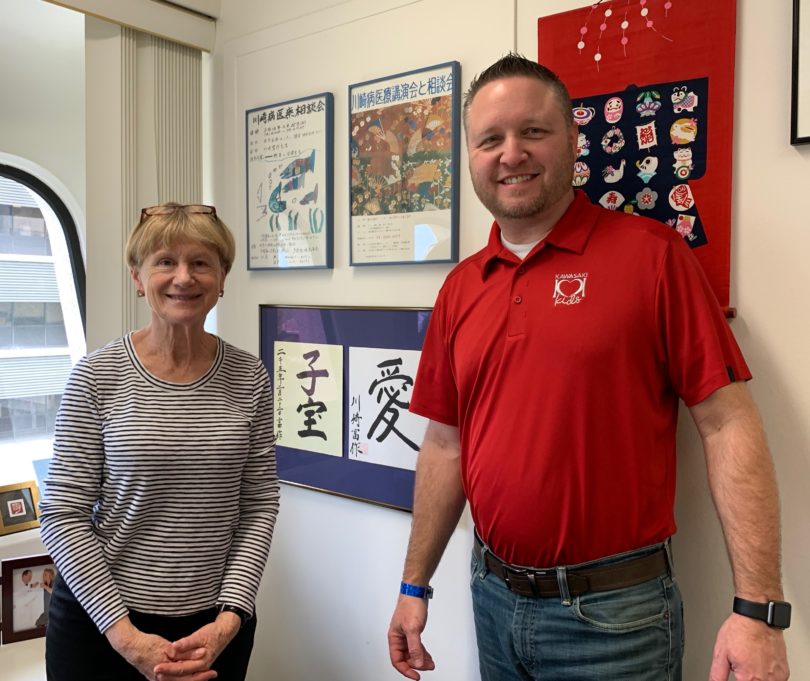
CLICK HERE
When to see a doctor
Diagnosing and treating Kawasaki Disease within the first 10 days is CRUCIAL to prevent long-term damage.
If your child has a fever that lasts more than four days, contact your child’s doctor. Any or all of these symptoms may be present:
- Redness in both eyes
- A very red, swollen tongue
- Redness of the palms or soles
- Skin peeling
- A rash
- Swollen lymph nodes
- Irritability
- Decreased appetite
How is Kawasaki Disease Diagnosed?
Kawasaki Disease can be hard to diagnose because there is not a test for it. They will take a look at the whole picture of symptoms, your child’s age, and rule out other possible causes before formal diagnoses. Most doctors will order an echocardiogram to see if there is inflammation and then confirm Kawasaki Disease at that point.
Questions to ask your child’s doctor about Kawasaki Disease:
- Does my child need any tests?
- How long will the symptoms last?
- What treatments are available, and which do you recommend?
- What are the possible side effects of the treatments?
- Are there any steps I can take to make my child more comfortable?
- What signs or symptoms should I watch for that might indicate that he or she is getting worse?
- What’s my child’s long-term prognosis?
- Are there any brochures or other printed material that I can take home with me?
- What websites do you recommend visiting?
Kawasaki Disease Complications
Kawasaki Disease is a leading cause of acquired heart disease in children. With effective treatment, only a small percentage of children have lasting damage.
Heart complications include:
- Inflammation of blood vessels (vasculitis), usually the coronary arteries, that supply blood to the heart
- Inflammation of the heart muscle (myocarditis)
- Heart valve problems (mitral regurgitation)
- Abnormal heart rhythm (dysrhythmia)
Any of these complications can damage your child’s heart. Inflammation of the coronary arteries can lead to weakening and bulging of the artery wall (aneurysm). Aneurysms increase the risk of blood clots forming and blocking the artery, which could lead to a heart attack or cause life-threatening internal bleeding.
Some children may develop coronary artery problems, which can be fatal, even with treatment.
Kawasaki Disease Treatment
To reduce the risk of complications, your child’s doctor will want to begin treatment for Kawasaki disease as soon as possible after the appearance of signs and symptoms, preferably while your child still has a fever. The goals of initial treatment are to lower fever and inflammation and prevent heart damage.
To accomplish those goals, your child’s doctor may recommend:
- Gamma globulin. Infusion of an immune protein (gamma globulin) through a vein (intravenously) can lower the risk of coronary artery problems.
- Aspirin. High doses of aspirin may help treat inflammation. Aspirin can also decrease pain and joint inflammation, as well as reduce the fever. Kawasaki treatment is a rare exception to the rule against aspirin use in children.
Because of the risk of serious complications, initial treatment for Kawasaki disease usually is given in a hospital.
After the initial treatment
Once the fever goes down, your child may need to take low-dose aspirin for at least six weeks and longer if he or she develops a coronary artery aneurysm. Aspirin helps prevent clotting.
However, if your child develops flu or chickenpox during treatment, he or she may need to stop taking aspirin. Taking aspirin has been linked to Reye’s syndrome, a rare but serious illness that can affect the blood, liver, and brain of children and teenagers after a viral infection.
Without treatment, Kawasaki disease lasts an average of 12 days, though heart complications may be evident later and be longer lasting. With treatment, your child may start to improve soon after the first gamma globulin treatment.
Monitoring heart problems
If your child has any indication of heart problems, the doctor may recommend follow-up tests to monitor heart health at regular intervals, often at six to eight weeks after the illness began. If your child develops continuing heart problems, the doctor may refer you to a doctor who specializes in treating heart disease in children (pediatric cardiologist). In some cases, a child with a coronary artery aneurysm may require:
- Anticoagulant drugs. These medications — such as aspirin, clopidogrel (Plavix), warfarin (Coumadin) and heparin — help prevent clots from forming.
- Coronary artery angioplasty. This procedure opens arteries that have narrowed to the point that they impede blood flow to the heart.
- Stent placement. This procedure involves implanting a device in the clogged artery to help prop it open and decrease the chance of reblockage. Stent placement may accompany angioplasty.
- Coronary artery bypass graft. This operation involves rerouting the blood around a diseased coronary artery by grafting a section of blood vessel from the leg, chest or arm to use as the alternate route.]
Kawasaki Disease Causes
No one knows what causes Kawasaki disease, but scientists don’t believe it is contagious. A number of theories link the disease to bacteria, viruses or other environmental factors, but none has been proved. Certain genes may increase your child’s susceptibility to Kawasaki disease.
Kawasaki Disease Risk Factors
Three things are known to increase your child’s risk of developing Kawasaki disease, including:
- Age. Children under 5 years old are most at risk of Kawasaki disease.
- Sex. Boys are slightly more likely than girls are to develop Kawasaki disease.
- Ethnicity. Children of Asian descent, such as Japanese or Korean, have higher rates of Kawasaki disease.
